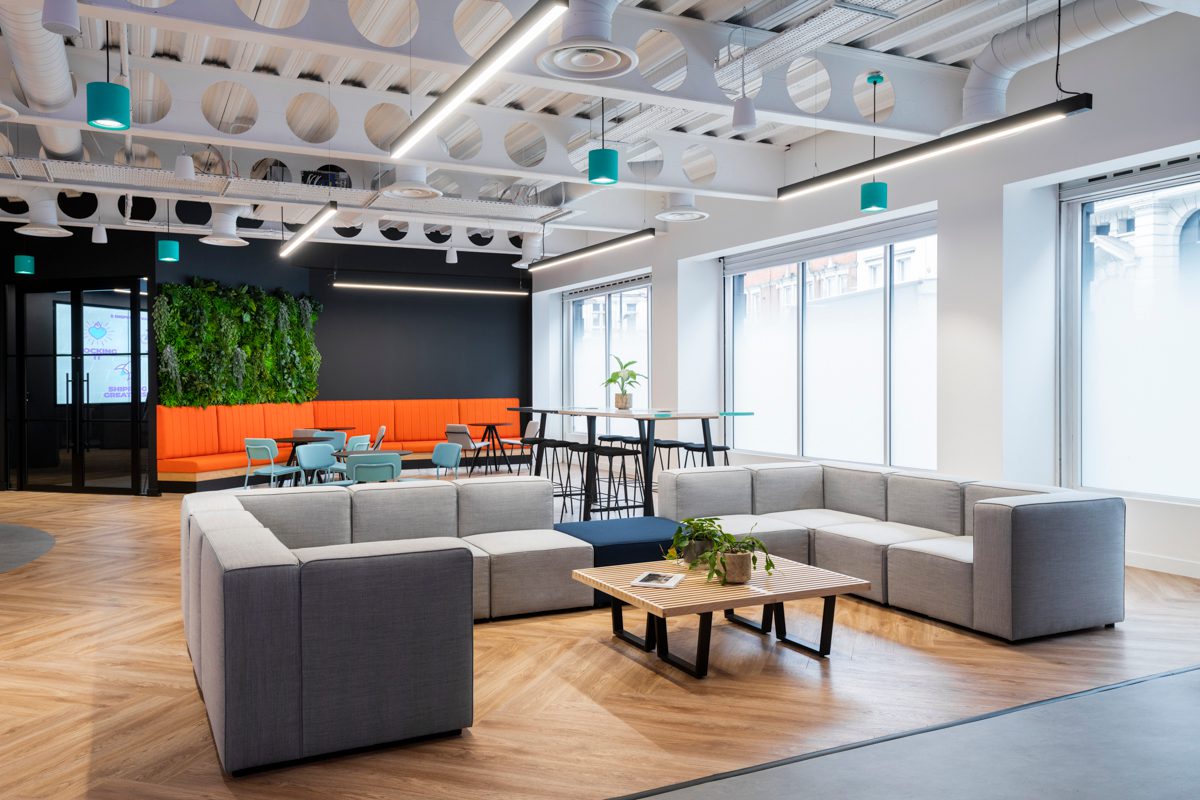The Psychology Behind Workplace Design Consultancy
It’s our job to understand the psychological impact of our design choices and how these influence those using a space for work.


Written by
Fritha Selwyn-Jones
Contents
There’s more behind an impactful workplace environment than aesthetics. Entering any space has a profound effect on us psychologically. Colours stimulate emotions, emotions feed into our approach to projects. Layouts determine how much or little we socialise with our coworkers, levels of collaboration and focus have an impact on productivity. How happy do staff feel in the space? Do they feel safe and supported? Does the space welcome them with accessible design that attends to their needs?
In this article, we’ll examine some of the core workplace design principles rooted in psychology.
The Impact of Colours
Colour has a significant impact on our mood, whether we realise it or not. Numerous studies have investigated the impact of colour on the human mind, and when we consider the state of mind of someone in the work environment, this research comes in handy.
When our eyes detect certain colours, neurotransmitters send signals to certain parts of our brains that regulate the autonomic nervous system and hormonal responses. That means that seeing certain colours can trigger the release of chemicals like cortisol (the ‘stress’ hormone) and serotonin (the ‘love’ hormone). These effects date back to our primal minds, where seeing a colour like red elicits an energetic and excited response due to plants displaying it as a warning sign, or other humans flushing red to signal aggression or arousal.
Our response to colour can also be culturally driven. In the West, the colour white is associated with purity, hygiene, and innocence, whereas in the East it is more commonly associated with death and mourning. We need to be careful taking these considerations into account when designing inclusively.
Colour is also important for brand perception in the workplace. The study Exciting Red and Competent Blue shows that purchasing intent is influenced by colours due to their impact on brand perception. Colour influences how consumers view a brand’s personality, so it’s vital we get this right the minute someone steps into your brand’s space.
Colour is a powerful tool for influencing emotions, and emotions directly impact the way we approach work. What emotions do we want to encourage in the workplace?
Happiness
Calmness
Confidence
Inspiration
Motivation
Belonging
Empathy
Trust
What colours can we use to encourage these feelings and ensure we support an atmosphere conducive to work, without being overwhelming?
Yellow: A colour known for its cheerful and uplifting qualities. Yellow is a colour that encourages optimising and energy, creating a happy atmosphere. It is best used in accents to prevent it from becoming too overbearing.
Blue: A colour of calmness and serenity, blue lowers stress, promotes feelings of calm, and helps us feel more peaceful and serene. Blue is one of the most popular colours in interior design to support wellnesss.
Green: Green is not only a colour of balance and harmony, insituating confidence in the workplace; it is also closely associated with nature. We’ve extensively discussed how natural elements support well-being at work, so tones of green are important.
Purple: Long associated with wisdom and luxury, purple is a dynamic colour that pairs the stability of blue with the energetic vitality of red. Purple reflects confidence and inspiration and is a colour often linked with creativity.
Orange: An energising colour, orange encourages enthusiasm and excitement. Its warmth and vibrancy make it perfect for inspiring creativity and motivation. Orange stimulates mental activity and encourages social interaction, which can be useful in collaborative workspaces.
Red: A highly stimulating colour, red increases heart rate and adrenaline, making it ideal for promoting action and motivation. It grabs attention and can instil a sense of urgency or excitement, which is useful in environments where quick decision-making or high energy is needed. Too much red can be stressful, so stick to accents only.

Space Layout and Productivity
A well-considered layout can break the monotony, promote positive mood, and strengthen brand image. When employees, clients, or stakeholders walk into a space, their brains will immediately register aesthetics in layout. Spending longer in the space, they subconsciously perceive aspects of its functionality and practicality. Furniture placement has an impact on our mood that we might not directly register at all, but it’s definitely there, so it’s the responsibility of furniture consultants to make sure great opportunities are seized, and pitfalls are avoided that could lead to frustration, inefficiency, and disengagement.
Open Plan and Private Spaces
The traditional open-plan office became somewhat controversial as employee health and wellbeing stepped more into the spotlight at the end of the last century. Today, having learned from the design world's successes and mistakes, the optimal approach to workplace layout is a flexible one. Let’s see why.
Open spaces encourage spontaneous communication and collaboration, fostering innovation and problem-solving.
Open layouts make leadership more visible and approachable, promoting an inclusive atmosphere with easier access to colleagues.
Open plans can increase noise and distractions, hindering focus for tasks that require deep concentration.
Lack of personal space in open layouts can reduce privacy and make employees feel self-conscious, impacting focus and comfort.
Offering both open and private spaces allows employees to choose the best environment for specific tasks, improving focus and productivity.
Private areas provide necessary quiet zones for decompression, reducing stress and supporting mental health.
Flexible layouts support different work styles, catering to those who need collaboration or quiet focus, and optimising individual productivity.
Flexible spaces help employees transition between collaborative in-office work and remote tasks, supporting modern hybrid work models.
Wayfinding, Zoning, and Flow
Employees should be able to move freely and easily within the workplace and identify different areas for different needs. This will increase productivity and the flow of movement within the space. We want to avoid physical or psychological barriers that disrupt workflows and aim to create logical pathways that guide employees through the space, ensuring frequently visited areas like meeting rooms and break spaces are easy to identify and access.
Techniques consultants use to achieve good wayfinding, zoning, and flow:
Strategically dividing the space into distinct zones for different needs.
Using signage, or more subtly, colour and visual cues like floor patterns.
Place frequently used areas together to prevent unnecessary movement and distraction in other spaces.
Creating open sightlines with fewer barriers to make it easier for employees to identify key areas.
Building circulation paths into the space to minimise obstructions and bottlenecks.
Using modular and moveable furniture and partitions that can be reconfigured as needed.
Building logical zones and pathways in a workplace reduces wasted time, stress, and mental fatigue. It’s also a good way of supporting creative thinking. By allowing staff to move about and change their work environment, switch to a standing desk, or even move to an area with different lighting, they can regulate energy levels and enhance their cognitive function.
It’s important to ensure workers feel comfortable in the space, especially a large space broken up by furnishings and partitions. A study on perceived workplace layout design and work-related physical activity and sitting time found some interesting behaviours related to how office layout affected physical activity:
In shared and open-plan offices, greater "connectivity"—referring to how easily people can access spaces—was associated with increased physical activity. Specifically, local connectivity led to more work-related physical activity, while overall connectivity increased the likelihood of activity but didn't necessarily result in longer activity durations.
In contrast, private-enclosed offices showed no significant relationship between layout and physical activity, but better overall connectivity reduced sedentary time.
The proximity and visibility of coworkers in open-plan offices were linked to more sedentary behaviour, possibly due to social pressures. Workers may have felt discouraged from moving to avoid disrupting others or being judged.


Natural Elements and Mental Health
It is well known and well documented that incorporating natural elements into the workplace reduces stress levels and supports better mental health. Here are a few ways this works, backed by science:
A study on natural light and mental health found that both natural elements and exposure to sunlight (direct and indirect) were positively associated with improved employee mental health and work attitudes.
A study on the impact of the modularised interior landscape on psychological wellbeing found that incorporating plants and other natural elements into the workspace has been shown to alleviate stress, improve mood, and enhance psychological well-being.
A review on the effects of workplace nature-based interventions (NBIs) on the mental health reported that NBIs consistently showed positive effects in improving mental health indications, such as reducing symptoms of depression and anxiety and enhancing cognitive performance.
A holistic review of relations between office workspace design and mental health found that enhancements in daylight, layout design, and thermal comfort were found to positively impact various mental health indicators, extending beyond productivity to stress reduction, fatigue, and overall well-being.
If you want to harness the psychological potential of your workplace, Sketch Studios is a good place to start. We design workplaces holistically, always with employee wellbeing at the core of our approach.
Published on
September 19, 2024
Related Articles













